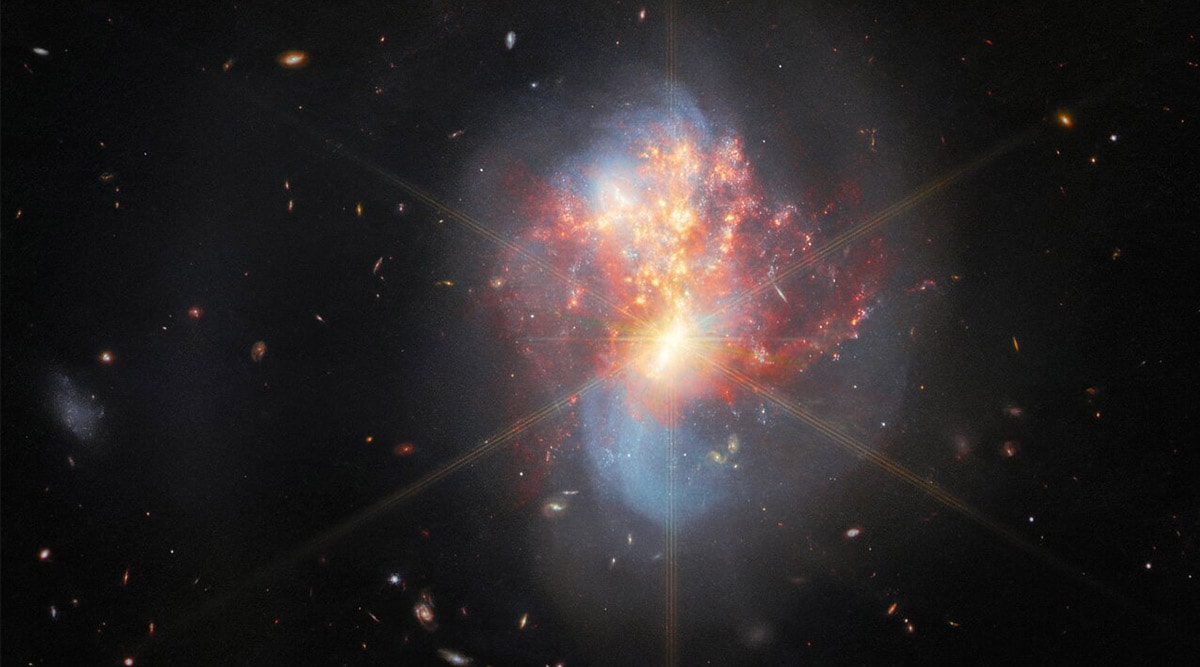This week is a happy one for all the UFO enthusiasts out there as a declassified version of the United States defence-intelligence report on UFOs is expected to be made public in the coming days. While it is unlikely that we will hear about aliens in the report, it could still present interesting insights into the world of “unidentified aerial phenomena,” or UAPs. Read about that and more in our weekly space news recap.
Webb captures Galaxies merging in a shroud of dust
The James Webb Space Telescope captured this image of galaxies plunging into one another in a galactic merger. Named IC 1623, the merger is happening about 270 million light-years away from us in the direction of the constellation Cetus.
The collision of these two galaxies triggers a deluge of rapid star formation, known as starburst. This starburst is forming stars at a rate that is twenty times higher than the rate of star formation in our galaxy, the Milky Way. This rapid starburst sends out intense infrared radiation that allowed Webb to capture the phenomena through clouds of dust and gas.
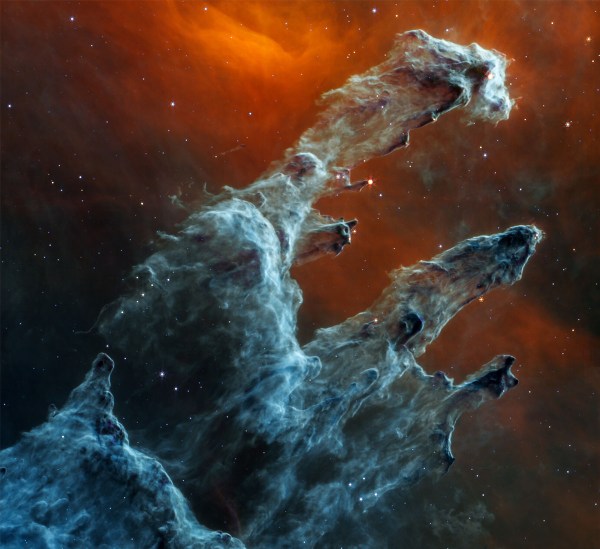 James Webb Space Telescope’s MIRI image of the pillars of creation is missing many of the stars that can be seen in other images.
James Webb Space Telescope’s MIRI image of the pillars of creation is missing many of the stars that can be seen in other images.
‘Haunting portrait’ of pillars of creation
This eerie image is not an artist’s impression of futuristic space ghosts but it is actually a mid-infrared image of the “pillars of creation” captured by the James Webb Space Telescope. The pillars of creation are clouds of interstellar gas in the Eagle Nebula.
An earlier near-infrared image of the pillars of creation captured by Webb shows thousands and thousands of stars forming in the region but many of these images are missing in the MIRI (mid-infrared instrument) image. The ESA says this is because many of the newborn stars no longer have “cloaks” of dust that can be detected in mid-infrared light.
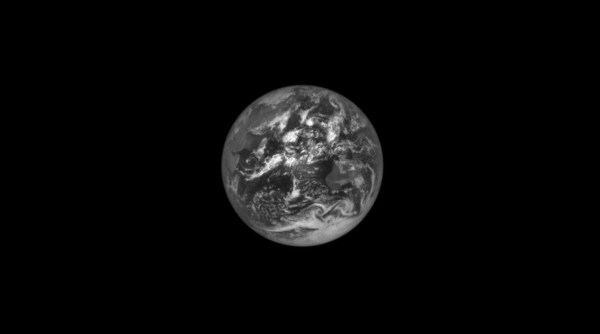
 NASA’s Lucy spacecraft captured this image of the Earth from about 620,000 kilometres away. (Image credit: NASA/Goddard/SwRI)
NASA’s Lucy spacecraft captured this image of the Earth from about 620,000 kilometres away. (Image credit: NASA/Goddard/SwRI)

 You might have to turn up your brightness to spot the Moon in this image. (Image credit: NASA/Goddard/SwRI)
You might have to turn up your brightness to spot the Moon in this image. (Image credit: NASA/Goddard/SwRI)
The Earth and Moon from far away
NASA’s Lucy spacecraft is currently on an epic journey to the Trojan asteroids which share Jupiter’s orbit with the Sun. While on its journey, Lucy captured images of the Earth from about 620,000 kilometres away and images of the Earth and the Moon from about 1.4 million kilometres away.
The images were taken by Lucy as part of its instrument calibration sequence as it approached the Earth for a gravity assist. The mission has two more such planned Earth gravity assists, where the spacecraft will approach the Earth to use the planet’s gravity to get up to the speed it needs to reach to approach the Trojan asteroids.
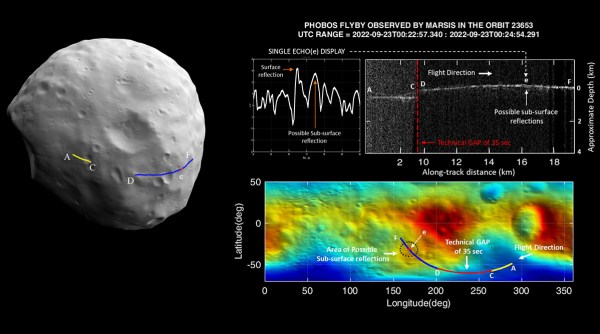
 The MARSIS instrument on Mars Express was able to “peer beneath the surface” of Phobos thanks to its new software update. (Image credit: INAF – Istituto Nazionale di Astrofisica)
The MARSIS instrument on Mars Express was able to “peer beneath the surface” of Phobos thanks to its new software update. (Image credit: INAF – Istituto Nazionale di Astrofisica)
Mysterious Martian moon
The MARSIS instrument on ESA’s Mars Express spacecraft was initially designed to study the internal structure of Mars, meaning that it worked best at the typical distance between the spacecraft and the planet’s surface, which was about 250 kilometres. But a recently made software update allows the instrument to be used at much closer distances, which means that scientists can study the origin of the mysterious Martian moon Phobos better.
While the software upgrade to the MARSIS instrument will shed new light on Phobos, scientists will have to wait a little longer for more detailed data till the Martian Moons eXploration (MMX) mission is launched. Scheduled for a 2024 launch, JAXA-led (Japanese Aerospace Exploration Agency) MMX mission is designed to land on Phobos and return samples of its surface back to Earth.
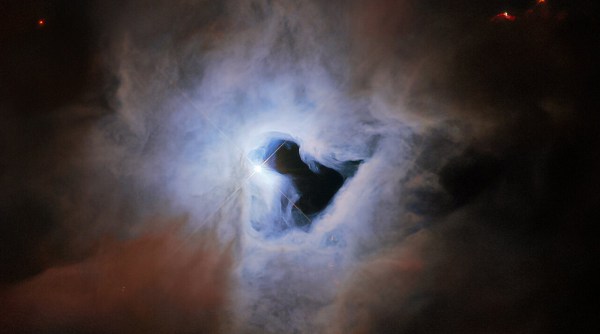
 NGC 1999, the reflection nebula in this Hubble image, is around 1,350 light-years away from out planet. (Image credit ESA/Hubble & NASA, ESO, K. Noll)
NGC 1999, the reflection nebula in this Hubble image, is around 1,350 light-years away from out planet. (Image credit ESA/Hubble & NASA, ESO, K. Noll)
Cosmic keyhole
Starring in this curious image taken by the Hubble Space Telescope is NGC 1999, a reflection nebula that is around 1,350 light-years away in the constellation Orion. According to ESA, the reflection nebula is the closest region of massive star formation to Earth.
The most remarkable aspect of this image is probably the gaping hole at its centre, which seems to contain the inky emptiness of space. When the nebula was captured in 1999, astronomers believed that the dark patch was something called a Bok Globule, which is the name for a dense, cold cloud of gas, molecules and cosmic dust that blots out light from the background.
But follow-up observations revealed the truth that is far less exciting. The patch is actually just na empty region of space. But what is interesting is that scientists still cannot decipher why there is a mysterious “cosmic keyhole” at the centre of the nebula.

 Starship prototypes are pictured at the SpaceX South Texas launch site in Brownsville, Texas, U.S., May 22, 2022. REUTERS/Veronica G. Cardenas/File Photo
Starship prototypes are pictured at the SpaceX South Texas launch site in Brownsville, Texas, U.S., May 22, 2022. REUTERS/Veronica G. Cardenas/File Photo
SpaceX Starship launch schedule
Reuters reports that SpaceX is targeting an early December date to launch its Starship rocket system into orbit for the first time. This will be a crucial test flight for the private space company as it aims to fly NASA astronauts to the Moon in the next few years.
Once it is deployed, Starship will be SpaceX’s flagship rocket system and will succeed the company’s reusable Falcon 9 rockets. Starship will be a more powerful, fully reusable launch vehicle that will be capable of taking large batches of commercial satellites, space tourists and professional asteroids to space.
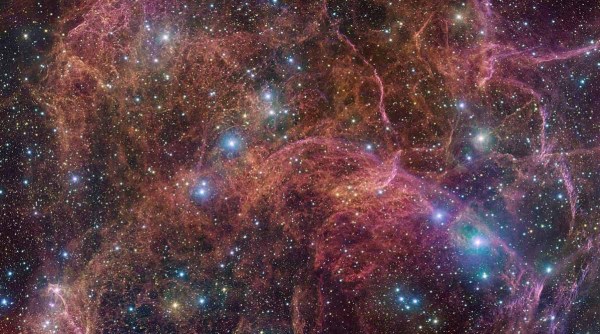
 An undated image shows a view of the orange and pink clouds that make up what remains after the explosive death of a massive star – the Vela supernova remnant. (Image credit: ESO/VPHAS+ team/Cambridge Astronomical Survey Unit/Handout via REUTER)
An undated image shows a view of the orange and pink clouds that make up what remains after the explosive death of a massive star – the Vela supernova remnant. (Image credit: ESO/VPHAS+ team/Cambridge Astronomical Survey Unit/Handout via REUTER)
Aftermath of a star’s death
An image released by the European Southern Observatory shows the aftermath of a large star’s explosive death, displaying filaments of brightly shining gas that was blasted into space by a supernova.
In the eerie image, you can spot clouds of gas that look like pink and orange tendrils. These gases cover a distance that is around 600 times larger than our entire solar system. The image shows the remnants of a supernova more than 11,000 years after it happened.
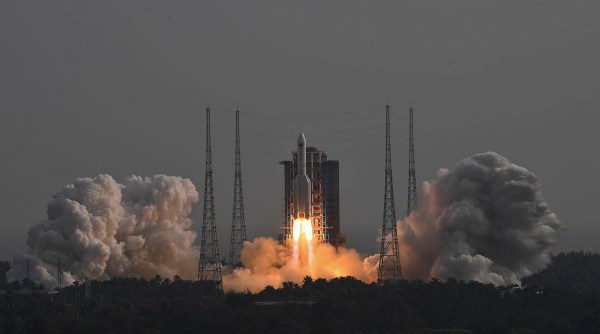
 In this photo released by Xinhua News Agency, the Long March-5B Y4 carrier rocket carrying the space lab module Mengtian, blasts off from the Wenchang Satellite Launch Center in south China’s Hainan Province, Monday, Oct. 31, 2022. China has launched the third and final module to complete its permanent space station, realizing a more than decade-long endeavor to maintain a constant crewed presence in orbit. (Hu Zhixuan/Xinhua via AP)
In this photo released by Xinhua News Agency, the Long March-5B Y4 carrier rocket carrying the space lab module Mengtian, blasts off from the Wenchang Satellite Launch Center in south China’s Hainan Province, Monday, Oct. 31, 2022. China has launched the third and final module to complete its permanent space station, realizing a more than decade-long endeavor to maintain a constant crewed presence in orbit. (Hu Zhixuan/Xinhua via AP)
China completes space station
China completed its Tiangong space station with the arrival and docking of Mengtian, its third and final module. The permanent station weighs about 66 tons, which is a fraction of the size of the International Space Station, which weighs around 465 tons.
According to AP, China’s crewed space officially became three decades old this year, with the Mengtian launch being the 25th mission of the program. But in a way, the program go truly underway only in 2003, when China became the third country in the world after the United States and Russia to put a human in space using its own resources.
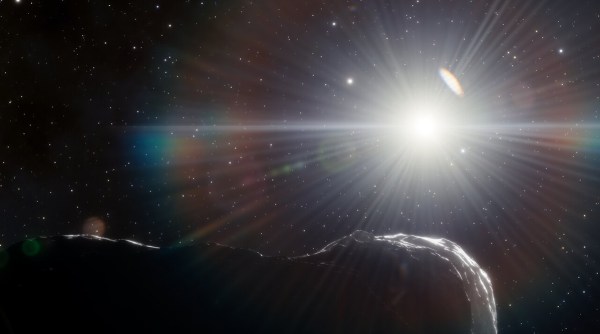
 Artist’s impression of a massive asteroid that orbits closer to the Sun than the Earth. (Image credit: NOIRLab)
Artist’s impression of a massive asteroid that orbits closer to the Sun than the Earth. (Image credit: NOIRLab)
‘Planet killer’ asteroid
Astronomers discovered three near-Earth asteroids hiding in the glare of the Sun. One of these is the largest “potentially hazardous” asteroid spotted in the last three years, according to NOIRLab.
“So far we have found two large near-Earth asteroids that are about 1 kilometre across, a size that we call planet killers,” said Scott S. Sheppard, lead author of the study published in The Astronomical Journal.
The newly-discovered asteroids are part of a population of asteroids that lurk between the orbits of Earth and Venus. According to NOIRLab, it is particularly challenging to make observations in this region because of the glare of the Sun.
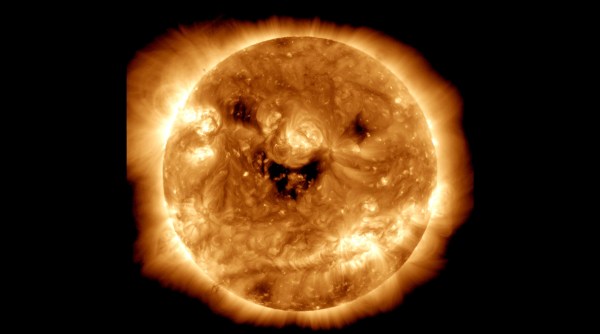
 In this image, the Sun seems to have two eyes, a bright round nose and a wide smile. (Image credit: NASA)
In this image, the Sun seems to have two eyes, a bright round nose and a wide smile. (Image credit: NASA)
Smiling Sun
In an image from the Solar Dynamics Observatory (SDO) released by NASA, it looks like the Sun has two eyes, a bright round nose and a wide-open smile. According to CNN, the dark areas that seemingly form a “face” on the Sun are coronal holes, which are cooler, denser regions in the Sun’s corona.
They appear dark in images taken in ultraviolet light, like this image. In this case, coincidentally, these dark areas seem to form what looks like a smiling face.
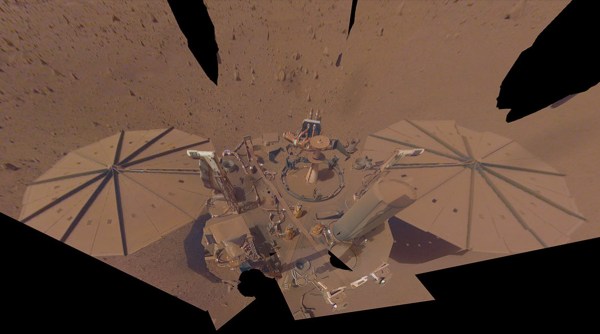
 NASA’s InSight rover captured this ‘selfie’ on April 24, 2022. (Image credit: NASA/JPL-Caltech)
NASA’s InSight rover captured this ‘selfie’ on April 24, 2022. (Image credit: NASA/JPL-Caltech)
End of InSight Mars lander’s life
After spending nearly four years on Mars, NASA’s InSight lander is coming to the end of its life as its power generation continues to decline due to the accumulation of dust on its solar panels. Currently, the InSight mission team is taking steps to make sure the lander continues working as long as possible with its remaining power.
The InSight mission will officially conclude when the lander misses two consecutive communication sessions with a spacecraft that is orbiting Mars. At this point, NASA will officially declare the mission over. However, the agency’s Deep Space Network will continue listening for signals from the lander for a short time.

 Deputy Director of U.S. Naval Intelligence Scott Bray points to a video of a ‘flyby’ as he testifies before a House Intelligence Counterterrorism, Counterintelligence, and Counterproliferation Subcommittee hearing about “Unidentified Aerial Phenomena,” in the first open congressional hearing on ‘UFOs’ in more than half-century, on Capitol Hill in Washington, U.S., May 17, 2022. REUTERS/Joey Roulette/File Photo
Deputy Director of U.S. Naval Intelligence Scott Bray points to a video of a ‘flyby’ as he testifies before a House Intelligence Counterterrorism, Counterintelligence, and Counterproliferation Subcommittee hearing about “Unidentified Aerial Phenomena,” in the first open congressional hearing on ‘UFOs’ in more than half-century, on Capitol Hill in Washington, U.S., May 17, 2022. REUTERS/Joey Roulette/File Photo
US government UFO report
Reuters reports that a declassified version of the latest United States government defence-intelligence report on “unidentified aerial phenomena,” (UAP) or UFOs, is expected to be made public in the coming days.
“There is no single explanation that addresses the majority of UAP reports. We are collecting as much data as we can, following the data where it leads, and will share our findings whenever possible,” Defense Department spokesperson Sue Gough said in a statement, according to Reuters.
While it is unlikely that the UAP report identifies any particular UAP as having an alien origin, it is still a possibility. Another possibility is for UAPs to be identified as advanced, hypersonic aerial spy vehicles flown by the United States’ foreign adversaries.
!function(f,b,e,v,n,t,s)
{if(f.fbq)return;n=f.fbq=function(){n.callMethod?
n.callMethod.apply(n,arguments):n.queue.push(arguments)};
if(!f._fbq)f._fbq=n;n.push=n;n.loaded=!0;n.version=’2.0′;
n.queue=[];t=b.createElement(e);t.async=!0;
t.src=v;s=b.getElementsByTagName(e)[0];
s.parentNode.insertBefore(t,s)}(window, document,’script’,
‘https://connect.facebook.net/en_US/fbevents.js’);
fbq(‘init’, ‘444470064056909’);
fbq(‘track’, ‘PageView’);


